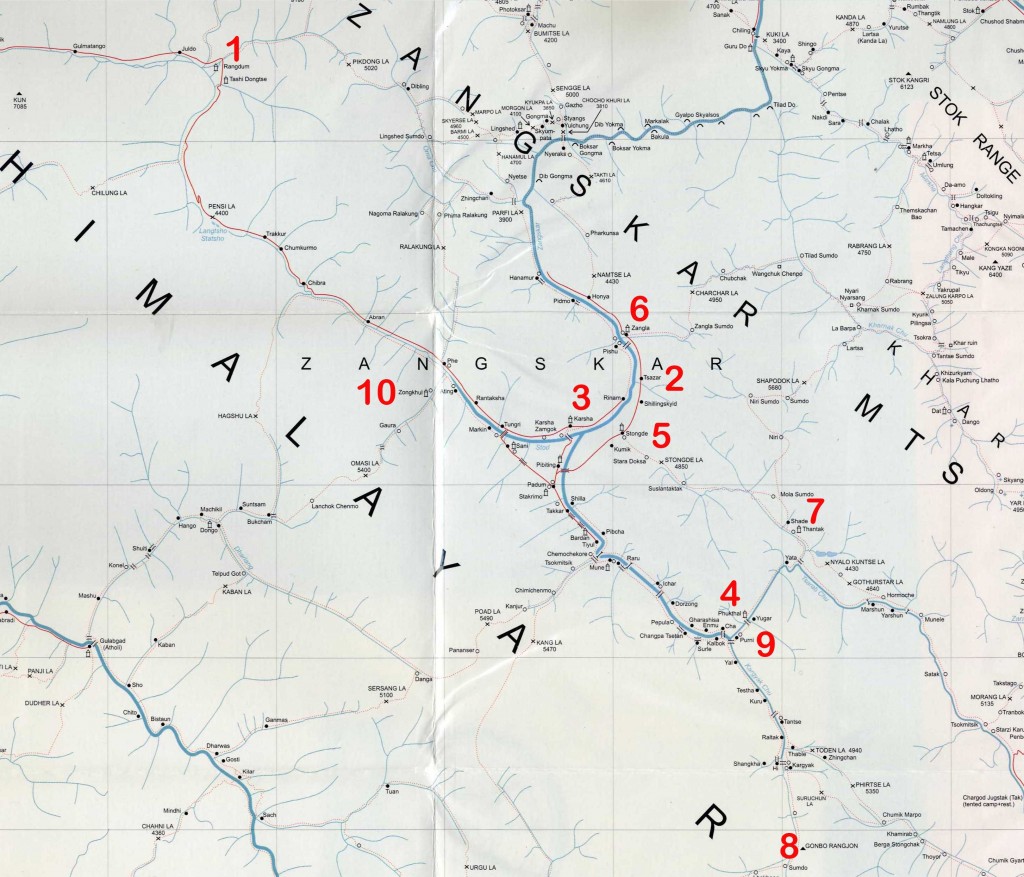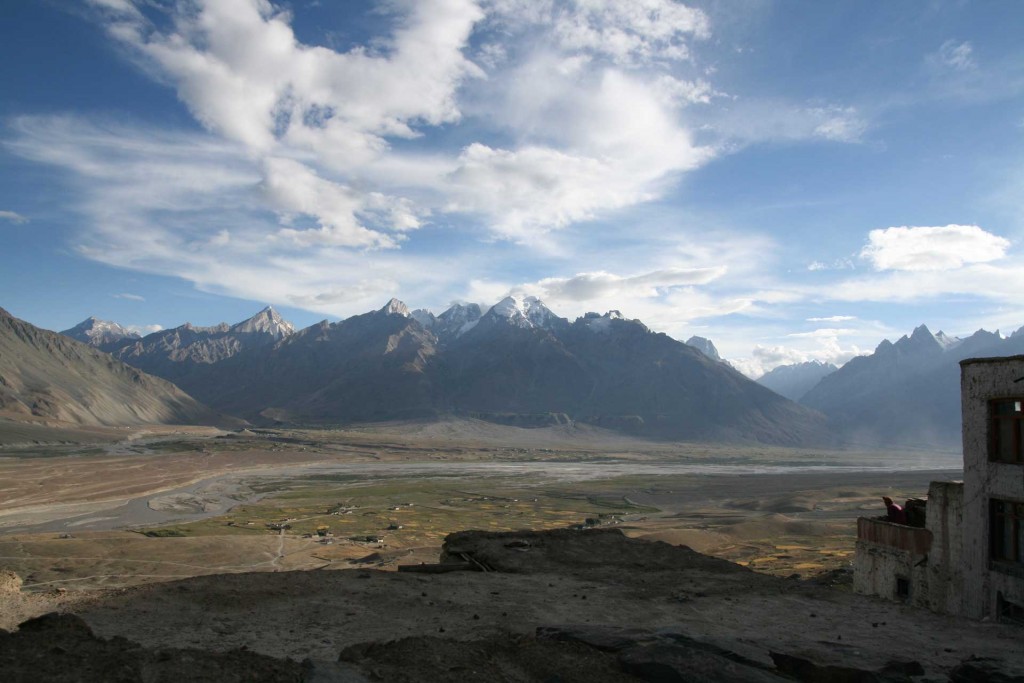Zanskar is a subdistrict or tehsil of the Kargil district, which lies in the eastern half of the Indian state of Jammu and Kashmir. The administrative centre is Padum. Zanskar, together with the neighbouring region of Ladakh, was briefly a part of the kingdom of Guge in Western Tibet.
The Zanskar Range is a mountain range in the Indian state of Jammu and Kashmir that separates Zanskar from Ladakh. Geologically, the Zanskar Range is part of the Tethys Himalaya, an approximately 100-km-wide synclinorium formed by strongly folded and imbricated, weakly metamorphosed sedimentary series. The average height of the Zanskar Range is about 6,000 m (19,700 ft). Its eastern part is known as Rupshu.
It also separates Kinnaur District from Spiti in Himachal Pradesh. The highest peaks of Himachal are in the Zanskar Range.
Best Time to Visit
Owing to the altitudes the Zanskar valley is accessible only during the summer months. The winter months are too harsh for travel in Zanskar. It is noteworthy that in the winter months the water of the River Zanskar freezes and becomes the Chador road.
How to Reach
BY ROAD - It is noteworthy that the road that links Zanskar with Kargil is open from mid July to early November. Buses. Jeeps, gypsies and taxis are easily available for transport to Zanskar from Kargil. Kargil is approximately 235 km away from Zanskar. During the months of June and July you may trek into Zanskar from Panikhar or Parkachik onwards.
The hill resort of Zanskar is one of the isolated and scantly inhabited Himalayan Valleys. Zanskar is wrapped in snow-covered peaks and boats of two small alpine lakes. But there is nothing comparable to the wonderful view of the "Drang-Drung" glacier.
Panikhar is an important place in the Zanskar Valley that is the border of the Suru Valley. At Panikhar the fort of Zorawar Singh is a major tourist attraction
Then there is the Penzella Pass that divides the Zanskar valley with the Suru Valley. Besides being the excellent camping site the Penzella Pass is a vintage point offering excellent views of the majestic mountains and the captivating countryside.
Karsha is a human settlement with basic facilities. The Gelugpa monastery at Karsha is a must visit to know the importance of the religion in the lives of the inhabitants of Zanskar. The mural art displayed at Labrang is other must check out in Zanskar
On the isolated mountains there are several places associated with the Tibetan Buddhists that are worth exploring
The adventure seekers may try river rafting from Serchu to Nyimu via Padam. Trekking is possible to Panikhar or Rangdum over the Pentse La, into the Zanskar Valley from Lamayuru, Leh or Darcha, from Padum to the Markha valley et al. The climatic conditions need to be kept in mind choosing the trek.
Kalyans Top 10 places in Zanskar

Overview of Kalyan’s favorite places. (Map by Sonam Tsetan & Henk Thoma)
1. Rangdum

Monastery Rangdum
Rangdum is surrounded by mountains and cliffs in all possible shades and colors. Most prominent, however, are the twin mountains Nun & Kun – both 7000s. For me, the mountain views make Rangdum a unique place in the world. In addition, the marshes of Rangdum attract every summer countless birds that are a pleasure to observe and admire. More personally, I associate Rangdum with many happy memories. From here I started the first trek of my life: one April, when the road to Zanskar was still blocked by the snow, I walked all the way to Zanskar over the Pensi La. Tip: Be sure to witness the sunset here! It is really unbelievable.
2. Tsazar

Kalyan’s village during winter
This is the village in which I was born and where I spent my early childhood. For me that’s reason enough to include this typical zanskari village in this list.
3. Karsha

View from Karsha monastery
Karsha is the village with the largest monastery of Zanskar. I love to join the morning Puja of the monks and watch the young novices, who might one day become important spiritual teachers of the country. The view of the central valley, from the monastery, is absolutely breathtaking
4. Phuktal

Phuktal is the most isolated monastery in Zanskar. I have often visited it, especially when I was hiking on the Great Zanskar Trek. To get there is always one of the biggest highlights in a trip. The sight and the architecture are truly breathtaking. The place always makes me think of a giant beehive.
5. Stongde

Stongde is the closest monastery to my village, which is why I have also spent a lot of time there. I appreciate the stillness of this place, in addition of course to the magnificent view of the mountains and the village at the foot of the monastery.
6. Zangla
Zangla is one of the largest villages of Zanskar. I love to walk through the town to watch the old people with their prayer wheels, sitting under the warm sun, and listen to them while murmur their prayers. Zangla is the village of my grandmother, and many of my relatives live here.
7. Shade

In Shade, people still live extremely isolated from the rest of the world
Shade is one of the most remote villages in the whole of Zanskar and Ladakh, if not the world. Even the natives, walking with fast feet over known trails, need at least two days to get here. I was there recently and it was very impressive to see how well here the interaction between man, animal and nature still works.
8. Gonbo Rangjon

Gonbo Rangjon is a spiritually important mountain for the Zanskari
Gonbo Rangjon, a sacred mountain, is located along the trekking route to Darcha, before Shingo La. I call the region around Gonbo Rangjon “the summer paradise of Zanskar”. It is a dream to wander here and admire the flowers that grow in the mountain pastures.
9. Purne

This beautiful little village is home to just two families. Purne is my favorite camping site, whenever I’m on a trekking tour. The first really nice and homelike Resthouse/Homestay/Hostal with clean rooms and good local food is also located in Purne.
10. Dzongkhul

Here is a meditation cave of Naropa and many other great lamas were here. From Dzongkhul also starts the route through the Paldar Valley. I’ve always liked the stories from travelers who came through this valley: the Paldar Valley connects Zanskar with Jammu and until today, people from both sides use it to meet, share and commerce with each other. Also Zorawar Singh, who took Ladakh from the hands of the Maharaja of Jammu, started his campaign here, leading ultimately to the loss of independence of the country


No comments:
Post a Comment